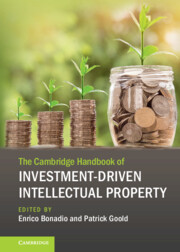Book contents
- The Cambridge Handbook of Investment-Driven Intellectual Property
- The Cambridge Handbook of Investment-Driven Intellectual Property
- Copyright page
- Contents
- Figures and Tables
- Contributors
- Foreword
- Introduction
- I Creativity, Pluralism, and Fictitious Narratives
- Part I Science, Technology and Industry
- Part II Culture and Entertainment
- Part III Signs, Images and Designs
- XV The Investment Function of Trade Marks
- XVI The Protection of Well-Known Trade Marks as a Way to Protect Investment?
- XVII Ambush Marketing and Protection of Investments
- XVIII EU Geographical Indications and the Protection of Producers and Their Investments
- XIX Design Right
- XX The Philosophical Foundations of Investment-Driven IP
XV - The Investment Function of Trade Marks
from Part III - Signs, Images and Designs
Published online by Cambridge University Press: 16 March 2023
- The Cambridge Handbook of Investment-Driven Intellectual Property
- The Cambridge Handbook of Investment-Driven Intellectual Property
- Copyright page
- Contents
- Figures and Tables
- Contributors
- Foreword
- Introduction
- I Creativity, Pluralism, and Fictitious Narratives
- Part I Science, Technology and Industry
- Part II Culture and Entertainment
- Part III Signs, Images and Designs
- XV The Investment Function of Trade Marks
- XVI The Protection of Well-Known Trade Marks as a Way to Protect Investment?
- XVII Ambush Marketing and Protection of Investments
- XVIII EU Geographical Indications and the Protection of Producers and Their Investments
- XIX Design Right
- XX The Philosophical Foundations of Investment-Driven IP
Summary
Much ink has been spilt by legislators, judges and scholars over the last 150 years in trying to answer this deceptively simple question: what is a trade mark?1 The reason that this is a deceptively simple question is that any attempt to answer it leads to further questions, which lead to yet other questions. Take the definition contained in section 3 of the Trade Marks Act 1905, which was the first definition in a UK statute: ‘A “trade mark” shall mean a mark used or proposed to be used upon or in connexion with goods for the purpose of indicating that that they are the goods of the proprietor by virtue of manufacture, selection, certification, dealing with or offer for sale.’ This somewhat cumbersome wording gave rise to a number of difficulties of interpretation and failed to allow for trade marks for services.2 Correcting that omission and putting the definition into more contemporary and simpler language, we might say that a trade mark is a sign whose function is to indicate the trade origin of goods or services. But that leads to questions such as: what is a sign for this purpose? And what exactly is meant by the trade origin of goods or services? It also leads to the questions which have become much debated in European trade mark law over the last 20 years or so: do trade marks have other functions in addition to their function of indicating trade origin, if so, what are those other functions and what effect does recognising such functions have on the scope of protection of trade marks?
- Type
- Chapter
- Information
- Publisher: Cambridge University PressPrint publication year: 2023



